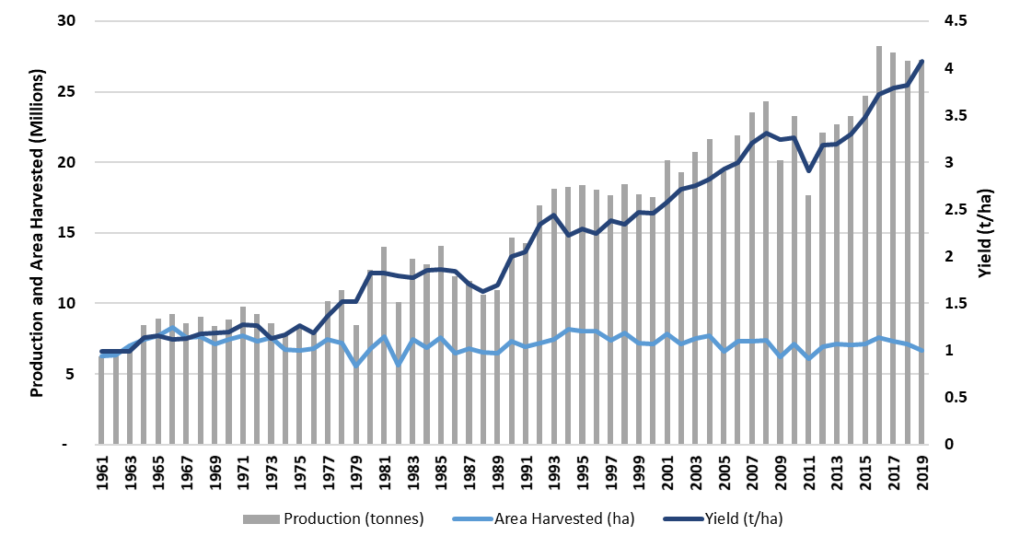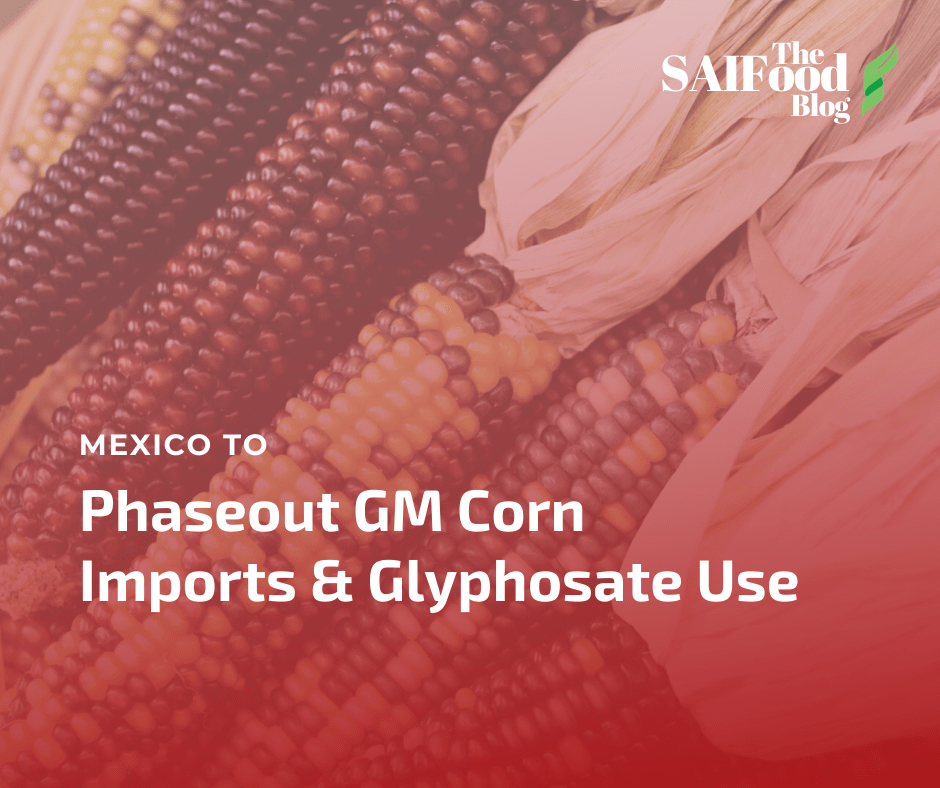On November 25th, 2019, the Mexican Secretariat of the Environment and Natural Resources (SEMARNAT) invoked the precautionary principle to deny the importation of 1,000 tons of glyphosate. Víctor Toledo, the Environmental Secretary at the time, expressed the “urgent need to promote an agroecology policy that eliminates the toxic effects of modern agriculture on the environment and society, which means the immediate ban of 111 pesticides classified as highly toxic (translated from Spanish).” This began SEMARNAT’s campaign of official communications and video presentations warning the public about the dangers of glyphosate use that continued until December 31st 2020. On that day, by presidential decree (unofficial English translation here) the use of glyphosate by public institutions was banned in Mexico. The government is now working with the private sector to completely phaseout the use of the agrichemical by no later than January 31st, 2024. Mexico’s outright ban of glyphosate was only a matter of time given the steps taken since the import denial.
What came as a complete surprise was the second component of the presidential decree, which referred to genetically modified (GM) crops. For this component, there was no lengthy information campaign building up to the decision. It states that by the first half of 2023, the legal framework to ban the field release of GM corn in Mexico will have been established. There is no GM corn cultivation in Mexico currently. So it’s unclear if the decree applies solely to corn for human consumption (white corn), or extends to animal feed as well (yellow corn, imported mostly from the U.S.). From the text of the decree, Mexican agroindustry believes that imports of GM corn will be phased out by 2024 (the decree is unclear on this).
No details regarding the implementation, timelines or which secretariats or agencies will be responsible for enacting and enforcing the requirements have been provided. Additionally, no information has been provided regarding how GM corn for human consumption will be defined. Nor, what, if any, corn-derived products might be affected.
Importance of Corn
Before exploring some possible economic implications of this policy decision, it is informative to explore the cultural and economic importance of corn in Mexico.
Mexico is considered the birthplace of cultivated corn; it has been cultivated there for some 7,000 to 10,000 years. In Mexico, corn isn’t simply another crop, it’s central to national identity (especially of indigenous groups). White corn is a staple food with an estimated consumption of 267 g/person/day (just over ½ a pound). In traditional agricultural systems, farmers play a wide range of roles with regard to seed production and maintenance. They conserve the genetic resources; they select and plant seed from their varieties; and, after harvest, they are the main consumers of their products. Currently, the country hosts the largest genetic diversity of corn in the world, with 59 different races that are valuable to crop breeding research.
Corn Production and Imports
White corn is the most important variety in terms of planted area (94% of total area) and production (91%), as it is used primarily for direct human consumption (Figure 1). The remaining 9% of corn produced is yellow corn, which is mainly used in animal feed. On average, over the last five years, in addition to its 25+ million tonnes of production Mexico has imported 14.1 million tons of corn per year. Practically all of this corn is imported from the U.S., and in 2019 imports were valued at $2.7 billion.

Source: FAO STAT 2021
Glyphosate is used to eliminate in-crop weeds, and in the mid-1990s plant scientists developed GM crops tolerant to it. This allowed for the agri-chemical to be sprayed on fields of corn, canola, cotton and soybeans, without harming the tolerant crops and killing the weeds that compete with them for nutrients. If glyphosate were banned globally and GM herbicide tolerant crop technology was substituted for conventional seed technology, an annual loss of US$6.76 billion in global farm income could occur, and it could also result in lower production volumes of soybeans, corn and canola. The agri-chemical has received regulatory approval in the U.S., Canada, Australia, and the EU. To receive such approvals, glyphosate has been scrutinized to make sure it meets safety standards in all the mentioned countries. No such assessments were done in Mexico, instead it seems that evidence to backup the policy decision may have came from published studies.
In 2017, Mexican scientists gathered information (p. 153) that would contribute to the eventual phaseout of glyphosate and GM crops. The main source of information for their report was an IARC report that stated that glyphosate probably causes cancer. This conclusion is in sharp contrast to the ones reached by the regulatory agencies of the different countries mentioned above. Health Canada has issued the clearest rejection of IARC’s report, stating that “[n]o pesticide regulatory authority in the world currently considers glyphosate to be a cancer risk to humans at the levels at which humans are currently exposed.” Interestingly, the Mexican report was published in 2017, but it cites the Séralini, et al. (2012) paper that “showed” that lab rats fed with Roundup-tolerant GM corn gave them cancer. That very same year (2012), the Séralini paper was retracted over concerns about the validity of its findings.
Why would a Mexican report, supposedly gathering evidence to show that glyphosate and GM crops are toxic to human health, cite a discredited study?
Reasons Given to Phaseout GM Corn
References to food sovereignty, and the necessity to preserve the purity of local corn varieties were the main reasons given to ban GM corn in the presidential decree. What was not mentioned in the presidential decree, but was at the ministry of the environment, was the incidence of aflatoxins (most poisonous fungal toxin) in corn. In an official presentation in October 2020 (p. 15), based on a ‘two-year’ study, SEMARNAT stated that native corn accumulates 99% less aflatoxins than commercial hybrids. A 2018 paper assessing ‘twenty-one years’ worth of studies published in Nature, found that Bt corn (a GM corn variety) has on average 28.8% less concentration of cancer causing mycotoxins than conventional corn. This peer-reviewed article was not mentioned by SEMARNAT.
Another – and perhaps somewhat more justified – reason as to why GM corn was banned in Mexico, might have to do with an incident that occurred 20 years ago with these ‘hybrids.’ Controversy erupted in 2001 when Quist and Chapela reported that they had detected transgenes (genes of a GM hybrid) in local corn varieties in the mountains of Oaxaca. The results were immediately suspected of being flawed due to the methodology and the misrepresentation of a key reference. The article was retracted by the journal that published the article in 2002, stating “the evidence available is not sufficient to justify the publication.” The matter did not end there as researchers in 2003 called for the issue to be investigated further. Five years later, a similar study was done and found no detectable transgenes in Mexican corn. The issue seems to not have been revisited since, but it could be why some in Mexico call for the ‘purity’ of local corn to be safeguarded.
So what could happen due to the phasing out of both glyphosate and GM corn?
According to the National Agricultural Council (CNA), 50% of glyphosate is used in the south-western part of Mexico, and its ban without an alternative could result in a loss of 76 billion pesos to the agricultural economy of this region (US $3.9 billion).
Mexico is self-sufficient in white corn production. But feed corn for its domestic livestock industry is imported mainly from the US. Simple economic reasoning indicates that if GM corn imports from the US for feed are not substituted with an equally cheap commodity, prices for feed will increase. If corn feed price for livestock increases, then the price of beef, dairy and poultry products will increase. How will the Mexican population take to an increase in food prices? Given that the adoption rate for GM corn in Argentina, Brazil and the US are all over 90%, non-GM corn imports will need to be sourced further away, increasing the import costs.
Even the European Union “fiercely” opposed to GM crops had to accept economic reality on GM crop imports for feed, when study after study showed the negative implications of its strict opposition to GM crops. So they now make the exception for GM crops when it comes to livestock feed, because they don’t want livestock derived products (like beef) to increase in price.
A Final Thought
My aim isn’t to say whether banning GM corn and glyphosate is good or bad. That is for the Mexican people to decide. The question I ask myself is what could potentially happen because of this policy decision? The way I see it, it’s one thing to be against a way of doing things and presenting an alternative (grounded in reality), it’s another thing entirely to ban the main ingredient of large swaths of your domestic agro-industrial sectors with no concretely stated alternative. The presidential decree will transform Mexican agriculture. The last time an agricultural transformation was done in Mexico (ejido reform in 1992), an average of 400,000 Mexicans (mostly from poor rural areas) migrated to the US annually for the following five years. Only time will tell what fruits this policy decision bares.


